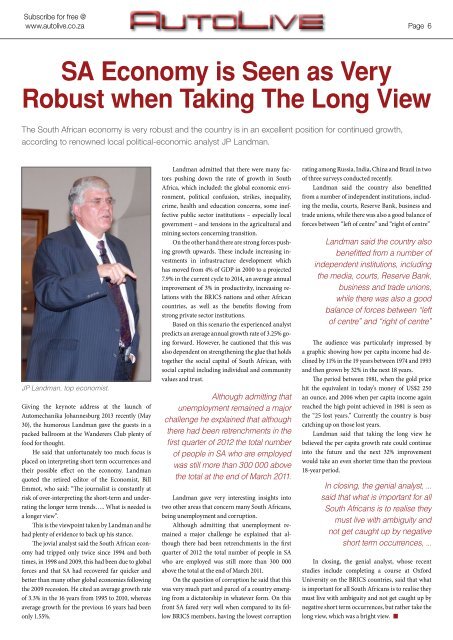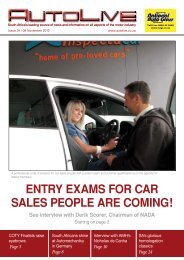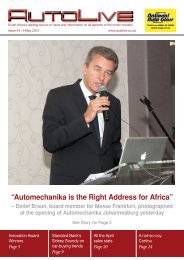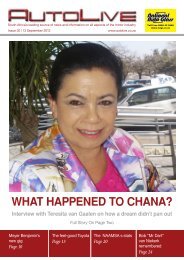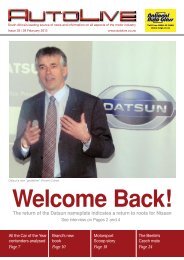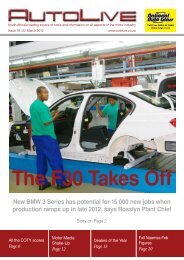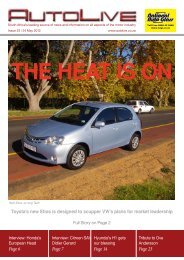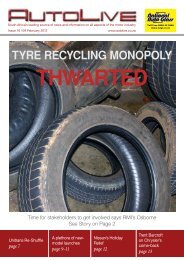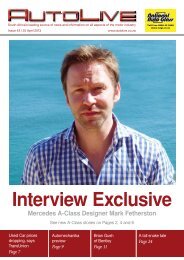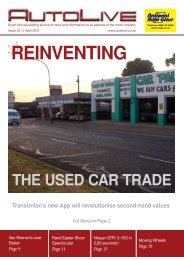You also want an ePaper? Increase the reach of your titles
YUMPU automatically turns print PDFs into web optimized ePapers that Google loves.
Subscribe for free @<br />
www.autolive.<strong>co</strong>.<strong>za</strong> Page 6<br />
SA E<strong>co</strong>nomy is Seen as Very<br />
Robust when Taking The Long View<br />
The South African e<strong>co</strong>nomy is very robust and the <strong>co</strong>untry is in an excellent position for <strong>co</strong>ntinued growth,<br />
ac<strong>co</strong>rding to renowned local political-e<strong>co</strong>nomic analyst JP Landman.<br />
JP Landman, top e<strong>co</strong>nomist.<br />
Giving the keynote address at the launch of<br />
Automechanika Johannesburg 2013 recently (May<br />
30), the humorous Landman gave the guests in a<br />
packed ballroom at the Wanderers Club plenty of<br />
food for thought.<br />
He said that unfortunately too much focus is<br />
placed on interpreting short term occurrences and<br />
their possible effect on the e<strong>co</strong>nomy. Landman<br />
quoted the retired editor of the E<strong>co</strong>nomist, Bill<br />
Emmot, who said: “The journalist is <strong>co</strong>nstantly at<br />
risk of over-interpreting the short-term and underrating<br />
the longer term trends….. What is needed is<br />
a longer view”.<br />
This is the viewpoint taken by Landman and he<br />
had plenty of evidence to back up his stance.<br />
The jovial analyst said the South African e<strong>co</strong>nomy<br />
had tripped only twice since 1994 and both<br />
times, in 1998 and 2009, this had been due to global<br />
forces and that SA had re<strong>co</strong>vered far quicker and<br />
better than many other global e<strong>co</strong>nomies following<br />
the 2009 recession. He cited an average growth rate<br />
of 3.3% in the 16 years from 1995 to 2010, whereas<br />
average growth for the previous 16 years had been<br />
only 1.55%.<br />
Landman admitted that there were many factors<br />
pushing down the rate of growth in South<br />
Africa, which included: the global e<strong>co</strong>nomic environment,<br />
political <strong>co</strong>nfusion, strikes, inequality,<br />
crime, health and education <strong>co</strong>ncerns, some ineffective<br />
public sector institutions – especially local<br />
government – and tensions in the agricultural and<br />
mining sectors <strong>co</strong>ncerning transition.<br />
On the other hand there are strong forces pushing<br />
growth upwards. These include increasing investments<br />
in infrastructure development which<br />
has moved from 4% of GDP in 2000 to a projected<br />
7.9% in the current cycle to 2014, an average annual<br />
improvement of 3% in productivity, increasing relations<br />
with the BRICS nations and other African<br />
<strong>co</strong>untries, as well as the benefits flowing from<br />
strong private sector institutions.<br />
Based on this scenario the experienced analyst<br />
predicts an average annual growth rate of 3.25% going<br />
forward. However, he cautioned that this was<br />
also dependent on strengthening the glue that holds<br />
together the social capital of South African, with<br />
social capital including individual and <strong>co</strong>mmunity<br />
values and trust.<br />
Although admitting that<br />
unemployment remained a major<br />
challenge he explained that although<br />
there had been retrenchments in the<br />
first quarter of 2012 the total number<br />
of people in SA who are employed<br />
was still more than 300 000 above<br />
the total at the end of March 2011.<br />
Landman gave very interesting insights into<br />
two other areas that <strong>co</strong>ncern many South Africans,<br />
being unemployment and <strong>co</strong>rruption.<br />
Although admitting that unemployment remained<br />
a major challenge he explained that although<br />
there had been retrenchments in the first<br />
quarter of 2012 the total number of people in SA<br />
who are employed was still more than 300 000<br />
above the total at the end of March 2011.<br />
On the question of <strong>co</strong>rruption he said that this<br />
was very much part and parcel of a <strong>co</strong>untry emerging<br />
from a dictatorship in whatever form. On this<br />
front SA fared very well when <strong>co</strong>mpared to its fellow<br />
BRICS members, having the lowest <strong>co</strong>rruption<br />
rating among Russia, India, China and Brazil in two<br />
of three surveys <strong>co</strong>nducted recently.<br />
Landman said the <strong>co</strong>untry also benefitted<br />
from a number of independent institutions, including<br />
the media, <strong>co</strong>urts, Reserve Bank, business and<br />
trade unions, while there was also a good balance of<br />
forces between “left of centre” and “right of centre”<br />
Landman said the <strong>co</strong>untry also<br />
benefitted from a number of<br />
independent institutions, including<br />
the media, <strong>co</strong>urts, Reserve Bank,<br />
business and trade unions,<br />
while there was also a good<br />
balance of forces between “left<br />
of centre” and “right of centre”<br />
The audience was particularly impressed by<br />
a graphic showing how per capita in<strong>co</strong>me had declined<br />
by 11% in the 19 years between 1974 and 1993<br />
and then grown by 32% in the next 18 years.<br />
The period between 1981, when the gold price<br />
hit the equivalent in today’s money of US$2 250<br />
an ounce, and 2006 when per capita in<strong>co</strong>me again<br />
reached the high point achieved in 1981 is seen as<br />
the “25 lost years.” Currently the <strong>co</strong>untry is busy<br />
catching up on those lost years.<br />
Landman said that taking the long view he<br />
believed the per capita growth rate <strong>co</strong>uld <strong>co</strong>ntinue<br />
into the future and the next 32% improvement<br />
would take an even shorter time than the previous<br />
18-year period.<br />
In closing, the genial analyst, ...<br />
said that what is important for all<br />
South Africans is to realise they<br />
must live with ambiguity and<br />
not get caught up by negative<br />
short term occurrences, ...<br />
In closing, the genial analyst, whose recent<br />
studies include <strong>co</strong>mpleting a <strong>co</strong>urse at Oxford<br />
University on the BRICS <strong>co</strong>untries, said that what<br />
is important for all South Africans is to realise they<br />
must live with ambiguity and not get caught up by<br />
negative short term occurrences, but rather take the<br />
long view, which was a bright view. ■


